Our Work
.
Coercive Control During Intimate Partner Violence: What About Children?
-
English
-
Français
Coercive Control During Intimate Partner Violence: What About Children?
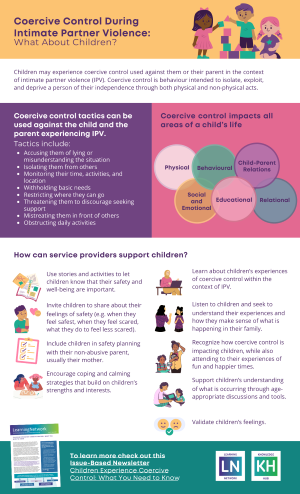
This Learning Network and Knowledge Hub infographic focuses on how children and parents experience coercive control during intimate partner violence, and what service providers can do to support children.
Authored by: Jasmine Sidhu
Children may experience coercive control used against them or their parent in the context of intimate partner violence (IPV). Coercive control is behaviour intended to isolate, exploit, and deprive a person of their independence through both physical and non-physical acts.
Coercive Control Tactics Can Be Used Against the Child and the Parent Experiencing IPV. Tactics include:
- Accusing them of lying or misunderstanding the situation
- Isolating them from others
- Monitoring their time, activities, and location
- Withholding basic needs
- Restricting where they can go
- Threatening them to discourage seeking support
- Mistreating them in front of others
- Obstructing daily activities
Coercive Control Impacts All Areas of a Child’s Life
- Physical
- Behavioural
- Child-Parent Relations
- Social and Emotional
- Educational
- Relational
How can service providers support children?
- Learn about children’s experiences of coercive control within the context of IPV.
- Listen to children and seek to understand their experiences and how they make sense of what is happening in their family.
- Recognize how coercive control is impacting children, while also attending to their experiences of fun and happier times.
- Support children’s understanding of what is occurring through age-appropriate discussions and tools.
- Use stories and activities to let children know that their safety and well-being are important.
- Invite children to share about their feelings of safety (e.g. when they feel safest, when they feel scared, what they do to feel less scared).
- Validate children’s feelings.
- Include children in safety planning with their non-abusive parent, usually their mother.
- Encourage coping and calming strategies that build on children’s strengths and interests.
Check out this Learning Network Issue-Based Newsletter Children Experience Coercive Control: What You Need to Know to learn more!
Join us in raising awareness about coercive control against children and parents on social media by sharing the following images:
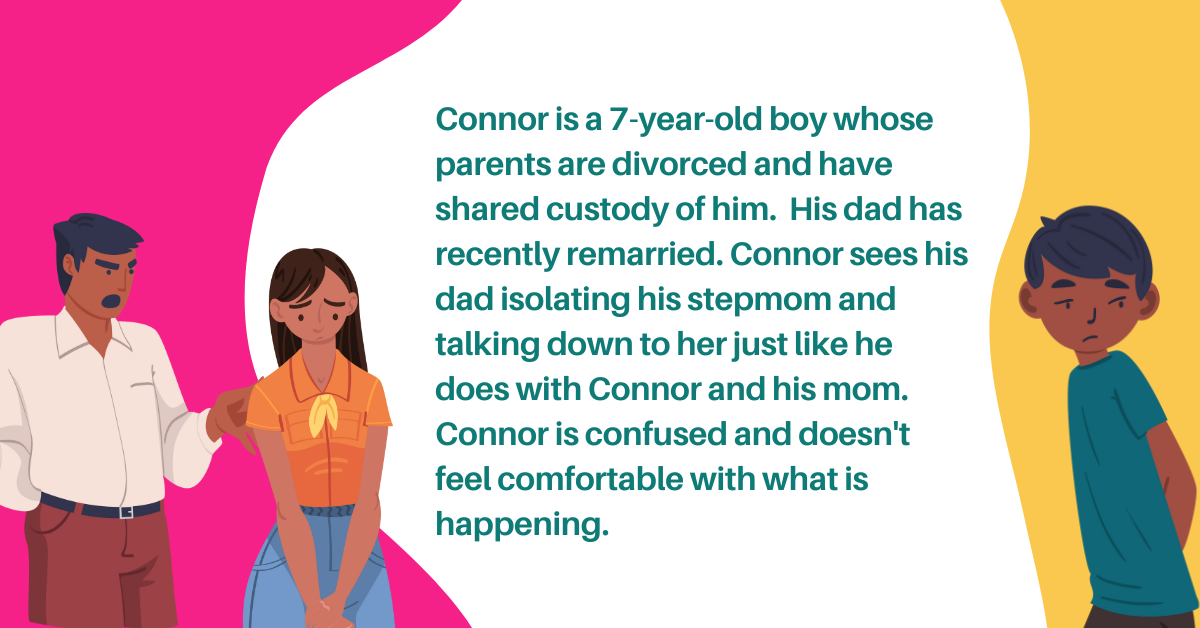
Connor is a 7-year-old boy whose parents are divorced and have shared custody of him. His dad has recently remarried. Connor sees his dad isolating his stepmom and talking down to her just like he does with Connor and his mom. Connor is confused and doesn't feel comfortable with what is happening.
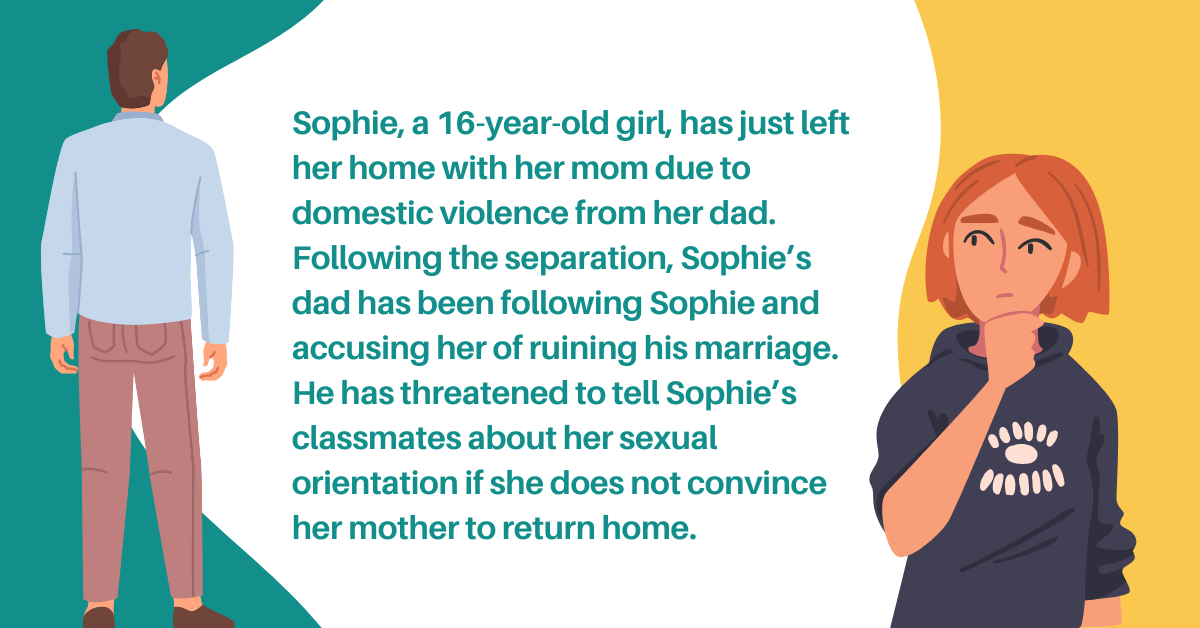
Sophie, a 16-year-old girl, has just left her home with her mom due to domestic violence from her dad. Following the separation, Sophie’s dad has been following Sophie and accusing her of ruining his marriage. He has threatened to tell Sophie’s classmates about her sexual orientation if she does not convince her mother to return home.
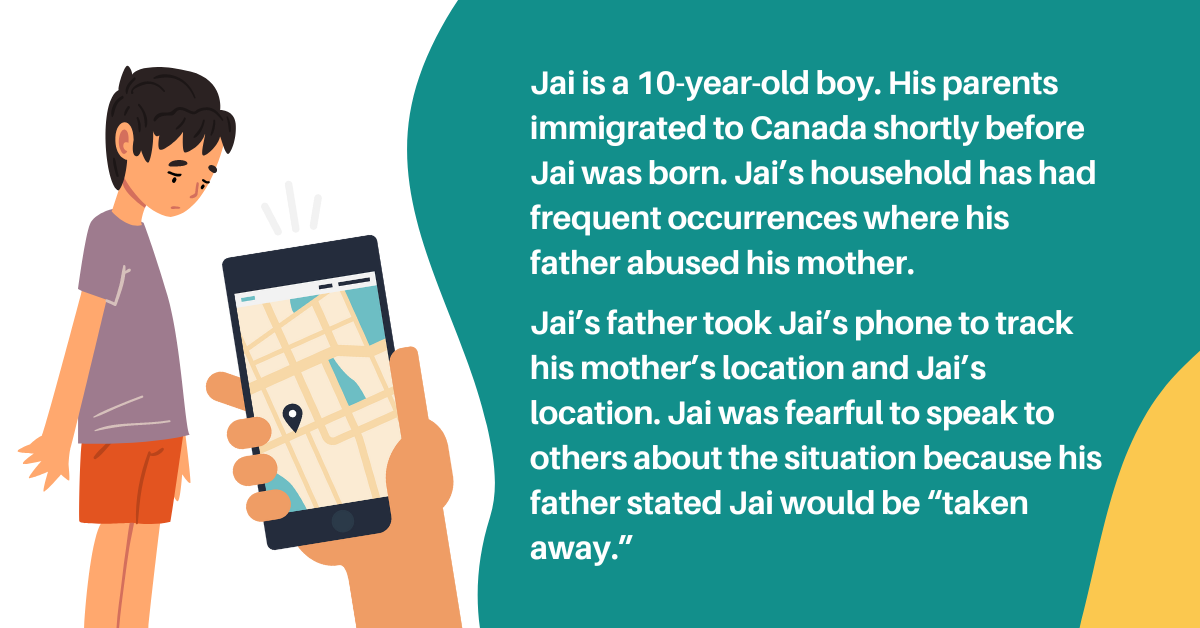 Jai is a 10-year-old boy. His parents immigrated to Canada shortly before Jai was born. Jai’s household has had frequent occurrences where his father abused his mother. Jai’s father took Jai’s phone to track his mother’s location and Jai’s location. Jai was fearful to speak to others about the situation because his father stated Jai would be “taken away.”
Jai is a 10-year-old boy. His parents immigrated to Canada shortly before Jai was born. Jai’s household has had frequent occurrences where his father abused his mother. Jai’s father took Jai’s phone to track his mother’s location and Jai’s location. Jai was fearful to speak to others about the situation because his father stated Jai would be “taken away.”
Le contrôle coercitif pendant la violence conjugale : qu’en est-il des enfants?
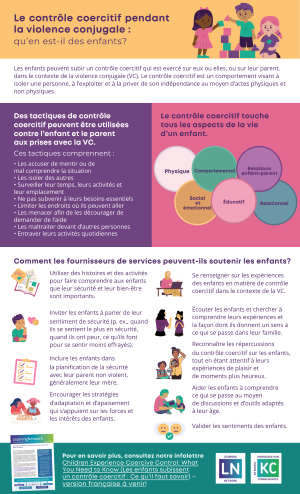
Cette Learning Network et Centre de connaissances infographie porte sur la façon dont les enfants et les parents subissent un contrôle coercitif pendant la violence conjugale, et explique ce que les fournisseurs de services peuvent faire pour soutenir les enfants.
Rédigé par : Jasmine Sidhu
Les enfants peuvent subir un contrôle coercitif qui est exercé sur eux ou elles, ou sur leur parent, dans le contexte de la violence conjugale (VC). Le contrôle coercitif est un comportement visant à isoler une personne, à l’exploiter et à la priver de son indépendance au moyen d’actes physiques et non physiques.
Des tactiques de contrôle coercitif peuvent être utilisées contre l’enfant et le parent aux prises avec la VC. Ces tactiques comprennent :
- Les accuser de mentir ou de mal comprendre la situation
- Les isoler des autres
- Surveiller leur temps, leurs activités et leur emplacement
- Ne pas subvenir à leurs besoins essentiels
- Limiter les endroits où ils peuvent aller
- Les menacer afin de les décourager de demander de l’aide
- Les maltraiter devant d’autres personnes
- Entraver leurs activités quotidiennes
Le contrôle coercitif touche tous les aspects de la vie d’un enfant
- Physique
- Social et émotionnel
- Comportemental
- Éducatif
- Relations enfant-parent
- Relationnel
Comment les fournisseurs de services peuvent-ils soutenir les enfants?
- Se renseigner sur les expériences des enfants en matière de contrôle coercitif dans le contexte de la VC.
- Écouter les enfants et chercher à comprendre leurs expériences et la façon dont ils donnent un sens à ce qui se passe dans leur famille.
- Reconnaître les répercussions du contrôle coercitif sur les enfants, tout en étant attentif à leurs expériences de plaisir et de moments plus heureux.
- Aider les enfants à comprendre ce qui se passe au moyen de discussions et d’outils adaptés à leur âge.
- Utiliser des histoires et des activités pour faire comprendre aux enfants que leur sécurité et leur bien-être sont importants.
- Inviter les enfants à parler de leur sentiment de sécurité (p. ex., quand ils se sentent le plus en sécurité, quand ils ont peur, ce qu’ils font pour se sentir moins effrayés).
- Valider les sentiments des enfants.
- Inclure les enfants dans la planification de la sécurité avec leur parent non violent, généralement leur mère.
- Encourager les stratégies d’adaptation et d’apaisement qui s’appuient sur les forces et les intérêts des enfants.
Pour en savoir plus, consultez ce Learning Network infolettre Children Experience Coercive Control: What You Need to Know (Les enfants subissent un contrôle coercitif : Ce qu’il faut savoir – version française à venir) !
Joignez-vous à nous pour sensibiliser les gens au contrôle coercitif exercé sur les enfants et les parents au moyen des médias sociaux en partageant les messages et les images ci-dessous :
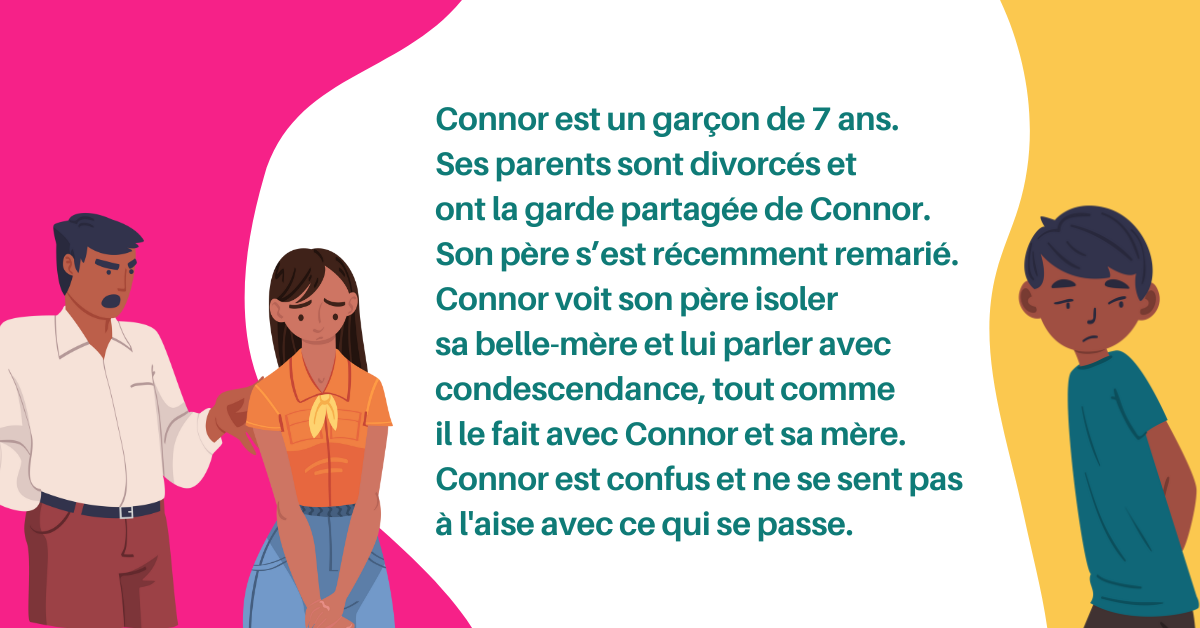
Connor est un garçon de 7 ans. Ses parents sont divorcés et ont la garde partagée de Connor. Son père s’est récemment remarié. Connor voit son père isoler sa belle-mère et lui parler avec condescendance, tout comme il le fait avec Connor et sa mère. Connor est confus et ne se sent pas à l'aise avec ce qui se passe.
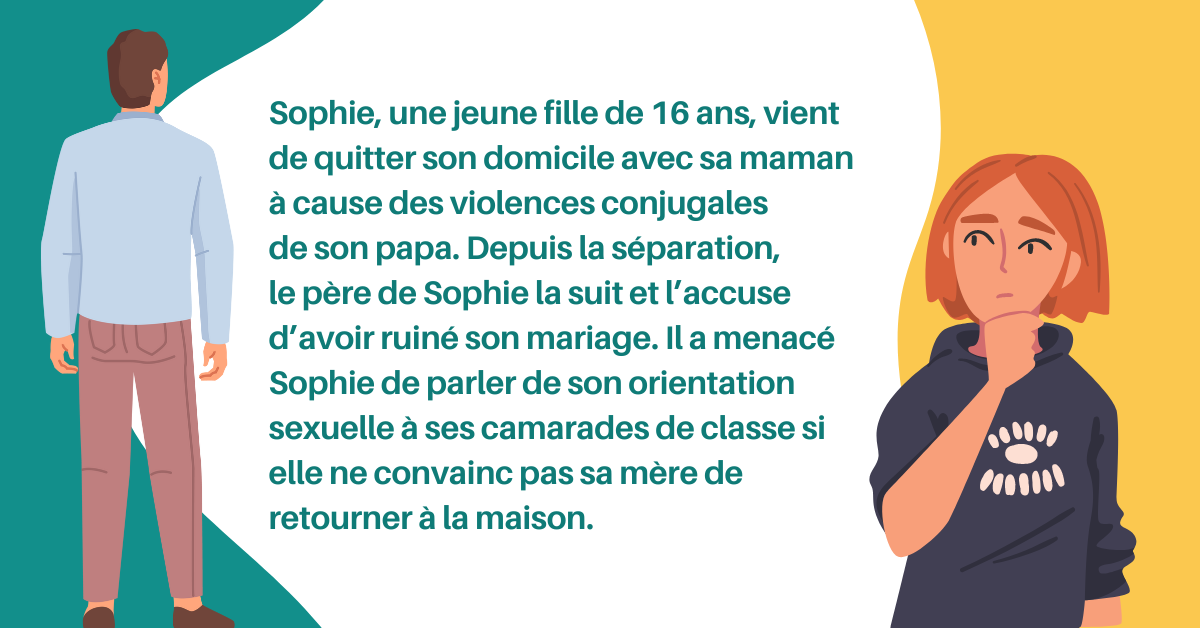
Sophie, une jeune fille de 16 ans, vient de quitter son domicile avec sa maman à cause des violences conjugales de son papa. Depuis la séparation, le père de Sophie la suit et l’accuse d’avoir ruiné son mariage. Il a menacé Sophie de parler de son orientation sexuelle à ses camarades de classe si elle ne convainc pas sa mère de retourner à la maison.
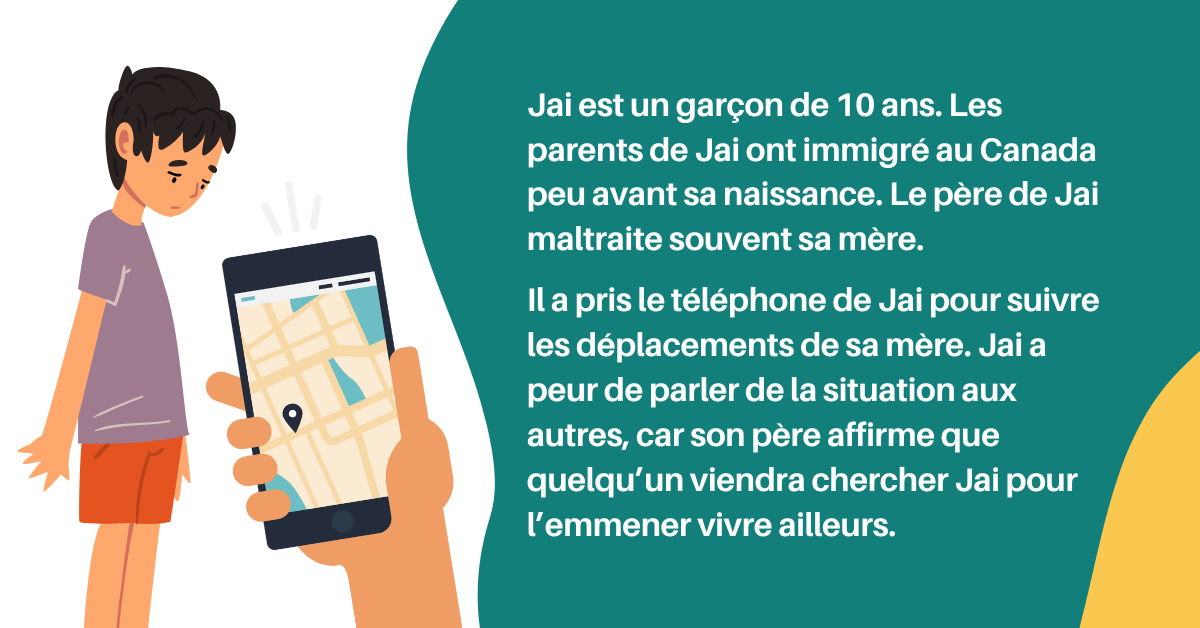
Jai est un garçon de 10 ans. Les parents de Jai ont immigré au Canada peu avant sa naissance. Le père de Jai maltraite souvent sa mère. Il a pris le téléphone de Jai pour suivre les déplacements de sa mère. Jai a peur de parler de la situation aux autres, car son père affirme que quelqu’un viendra chercher Jai pour l’emmener vivre ailleurs.





